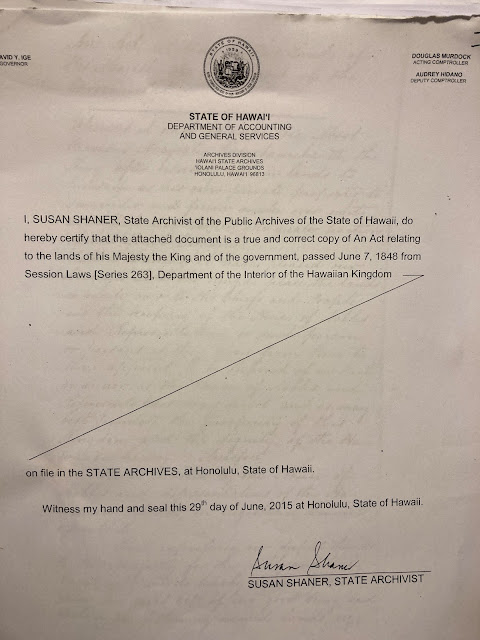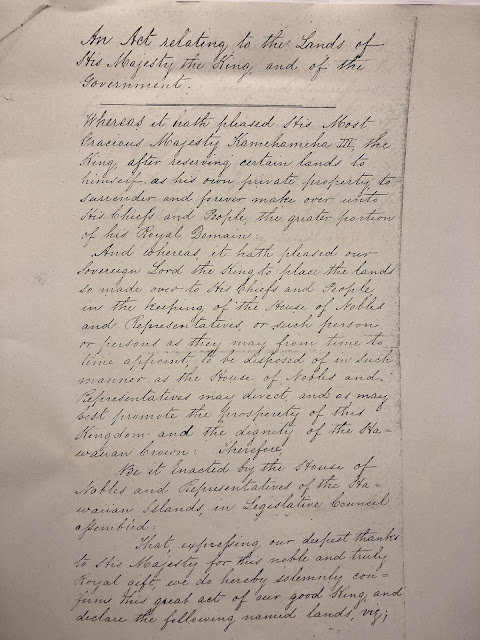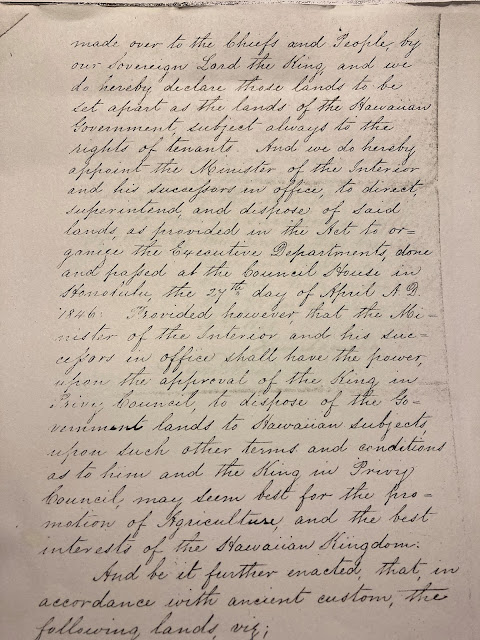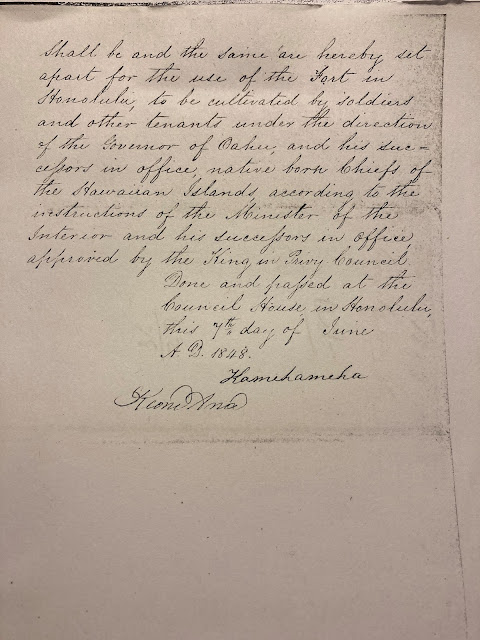The Legitimate Government in Hawaii Series: Kuhio/Kuhio Kalanianaole Piikoi, Stripped of His Title
Review by Amelia Gora (2021)
The following links applies as evidence about White Supremacist Supporter, Treasonous Person Prince Kuhio.
Kuhio lost his title "Prince", his lands when he supported the White Supremacist who dethroned Queen Liliuokalani in 1893.
Kuhio lost interest in the Crown Lands which was Kamehameha III's private properties. Kamehameha III documented that the Crown Lands was for himself, his heirs, and successors, forever.
The Government lands were to be overseen by the Hawaiian Kingdom's House of Nobles and assignments were to be made by the Hawaiian Kingdom's Minister of Interior.
See:
Kuhio, lost his title as Prince but the usurper entity State of Hawaii perpetuates wrongs and hide under deception, crimes of piracy, pillaging, genocide, racketeering etc.
Remembering Treasonous Prince Kuhio - The Saint of the Illegal State
posted by Amelia Gora (2017)
1897 - U.S. President Gave Hawaii Back to Queen Liliuokalani.
Reference:
Prince Kuhio and Kawananakoa failed to listen to their Aunt Kapiolani and filed her deed soon after they received it.
Queen Kapiolani had instructed them to file it After she died. She filed a case against them and the usurper court sided with Kuhio and Kawananakoa.
Queen Kapiolani maintained that they were to file it after she passed away.
Queen Kapiolani died in 1899:
| Kapiʻolani | |||||
|---|---|---|---|---|---|
| Queen of the Hawaiian Islands | |||||
 |
|||||
| Tenure | February 12, 1874 – January 20, 1891 |
||||
| Coronation | February 12, 1883, ʻIolani Palace[1][2] | ||||
| Born | December 31, 1834 Hilo, Hawaiʻi |
||||
| Died | June 24, 1899 (aged 64) Waikīkī, Hawaiʻi |
||||
| Burial | July 2, 1899[3] Mauna ʻAla Royal Mausoleum |
||||
| Spouse | Benjamin Nāmākēhā Kalākaua |
||||
|
|||||
| House | House of Kalākaua | ||||
| Father | Kūhiō Kalanianaʻole | ||||
| Mother | Kinoiki Kekaulike | ||||
| Religion | Church of Hawaii[4][5] | ||||
| Signature | |||||
1915 - Queen Liliuokalani was made Queen for a Day so that the usurpers could obtain her signatures for their plans.
1917 - Queen Liliuokalani died.
| Liliʻuokalani | |||||
|---|---|---|---|---|---|
 |
|||||
| Queen of the Hawaiian Islands (more...) | |||||
| Reign | January 29, 1891 – January 17, 1893 | ||||
| Predecessor | Kalākaua | ||||
| Successor | Monarchy overthrown | ||||
| Born | September 2, 1838 Honolulu, Oʻahu, Kingdom of Hawaii |
||||
| Died | November 11, 1917 (aged 79) Honolulu, Oʻahu, Territory of Hawaii |
||||
| Burial | November 18, 1917 Mauna ʻAla Royal Mausoleum |
||||
| Spouse | John Owen Dominis | ||||
|
|||||
| House | Kalākaua | ||||
| Father | Caesar Kapaʻakea | ||||
| Mother | Analea Keohokālole | ||||
| Religion | Protestantism (more...) | ||||
| Signature | |||||
Reference:
Prince Kuhio took an out of court settlement to the claims of Queen Liliuokalani.
The out of court settlement was Kuhio Beach.
Queen Liliuokalani had denied signing a Trust Deed with Cleghorn, Iaukea, et. als.







Replies
facebook:
Comments
tweet:
Conversation
1920 - Prince Kuhio moved to have Hawaii made a State:
A Treasonous Prince Kuhio Supporting the Identity Thieves - entity Provisional govt to Republic to Territory to State Defended by the U.S., and the American Empire
1921 - Prince Kuhio moved to set up the Hawaiian Homes Act.
Note: Prince Kuhio and Kawananakoa were Not the next in line to Queen Liliuokalani.
The Heirs documented were:
1) Princess Kaiulani
2) Princess Poomaikelani and her heirs
1) Alapai (w) fa: Kuluwailehua/Kuluailehua
2) Samuel fa: JWE Maikai
3) Haili/Kaili/Kalama (w) fa: Ioela
4) Elizabeth (w) fa: Mana
5) Abraham Kekai fa: Kekai
unnamed others.
3) Princess Kinoiki and her heirs
1) Prince Kuhio
2) Prince Kawananakoa
Note:
Prince Kuhio and Kawanakoa were claimed to be the next in line according to the "purported" Constitution written by Queen Liliuokalani, but it was the usurpers writings and their claims that Kuhio and Kawananakoa were the next in line.
The False Flag operations included setting up the Royal Families according to the plans of the usurpers.
The usurpers were operating a conspiracy network which included the United States, London, England and France due to documented evidence:
Premeditation of the U.S.
http://query.nytimes.com/mem/archive-free/pdf?res=9F0CE6DC1F3FEF33A2575AC0A9679C94629ED7CF
Premeditation of London, England:
http://iolani-theroyalhawk.blogspot.com/2017/03/london-conspiracy-annexation-should-be.html
Conspiracy which included France ----note: U.S., England, and France Funded the American Civil War and became bankrupt - They supported the U.S.
Opposition was made by Queen Liliuokalani, President Cleveland Gave Hawaii Back to Queen Liliuokalani and the continued conspiracy over assuming Private Properties of the Royal Families continued.... so using the Princes Kuhio and Kawananakoa was the continued goal in utilizing the Crown Lands.
The Crown Lands are the Private Properties of Kamehameha III - Kauikeaouli, for himself, his heirs, and successors.
The Hawaiian people are therefore used by the plans of the illegal occupiers who have no rights to occupy a neutral, friendly, non violent nation.
There was No Annexation.......see the legal article and see the promoters of crimes against the Royal Families through the moves of Treasonous persons Prince Kuhio and Prince Kawananakoa:
EXPOSING THE TREASONOUS JONAH KUHIO KALANIANAOLE AND DAVID KAWANANAKOA'S..Updated 4/07/2013
Jonah Kūhiō Kalanianaʻole
King Kalākaua (hānai)
Queen Kapiʻolani (hānai)
Kōloa, Kauaʻi
Waikīkī, Oʻahu
Mauna ʻAla Royal Mausoleum
Contents
[hide][edit]Early life
[edit]Prince of the Kalākaua Dynasty
[edit]Post-Overthrow Activities
[edit]From prince to American statesman
[edit]References
[edit]External links
Robert William Wilcox
from Territory of Hawaii
1903–1922
Henry Alexander Baldwin
David Kawānanakoa
Abigail Kapiʻolani Kawānanakoa
Lydia Liliʻuokalani Kawānanakoa
Kawānanakoa
King Kalākaua (hānai)
Queen Kapiʻolani (hānai)
Honolulu, Oʻahu
San Francisco, California
Mauna ʻAla Royal Mausoleum
Reference: https://maoliworld.ning.com/forum/topics/identity-theft-by-the-stat... Identity Thieves now known as the State of Hawaii through Pillaging, Piracy, fraud, identity theft for claiming to be the Hawaiian Kingdom/Kingdom of Hawaii, etc.
aloha.
https://www.youtube.com/watch?v=1zLTwQklddc
https://www.youtube.com/watch?v=MfAiB2ZoRhM
Amelia Gora
Kuhio a TREASONOUS Person...........documented......along with his brother Kawananakoa.........fyi...sharing how he is remembered on this Day, Kuhio Day celebrating LIES....
ShareFacebook
Views: 159
Replies to This Discussion
By Andrew Walden @ 10:13 PM :: 6894 Views :: DHHL, Agriculture, Hawaii History, Land Use
by Andrew Walden, Originally published January 22, 2015
At the moment colonized peoples won their freedom – and with it the right to use knowledge to advance themselves – metropolitans possessing the knowledge which had made the West prosperous and powerful suddenly began claiming Western knowledge was of no value. But that was the 1960s. Fifty years earlier, Prince Jonah Kuhio Kalanianaole didn’t suffer from that problem. Working to rehabilitate Hawaiians and make Hawaii ready for statehood, Kuhio focused his efforts on an American idea--homesteading.
Disagreements over homesteading burst into the open with Kuhio’s October, 1911 appeal to Republican President Taft against the reappointment of Hawaii Territorial Governor Walter F. Frear. As Delegate to Congress, Kuhio was the highest elected official in the Territory--Governors were appointed by the President.
In contrast to the leasehold assignments for Hawaiians-only which Kuhio would settle for a decade later in the Hawaiian Homes Commission Act, the homestead associations he championed in his first decade of service were multi-ethnic groups seeking the fee-simple ownership of land promised in the Hawaii Organic Act, article 73.
Kuhio’s complaint detailed strategies used by Frear to circumvent or corrupt homesteading of areas throughout the Territory, including:
In his August, 1907 inaugural address, Governor Frear had asserted:
But by 1911, none of the cane lands had been homesteaded.
Kuhio’s 60 page complaint against Frear is reprinted in his biography, ‘The Empty Throne” by Lori Kamae. In it Kuhio rips Frear for:
Referring often to a contemporary series of three articles by Progressive writer Ray Stannard Baker, Kuhio points out that in the four years of Frear’s administration, the Governor had not allowed homesteading on any of the 34,000 acres of cane planted on leased public lands. Kuhio explains, “considerable tracts of public land have been recently thrown open to homesteading” but “of a character utterly unfit for homesteading…. In this manner the Governor has sought to make a showing in favor of the policy of small proprietors, though well knowing that he was offering the homesteader only the husk, while keeping the meat for the sugar corporations.” (p233)
Describing specific homesteading efforts stymied by Frear, Kuhio argues: “it is (Frear’s) purpose, where he may be compelled to assign homesteads at all upon lands within or adjacent to plantations, they shall be so small in area as to insure the poverty of those who settle upon them, coupled with the necessity of the homesteaders to sell their surplus labor to the neighboring plantations….” (p 253-4) “This policy, if applied under the millions of cases arising under the Homestead Laws of the United States, would have paralyzed the settlement and civilization of the vast tracts of public land out of which so many thriving sovereign states have been created.” (p270)
In one of the articles cited by Kuhio, Baker describes an effort to build a sugar industry based on independent growers rather than plantation labor:
Baker, destined to be appointed to serve in the soon-to-be-elected Woodrow Wilson administration, complains bitterly about Asian immigration feeding the demand for labor, arguing:
This was the moment in American history when the impetus of Progressivism began its decades-long shift from Republican to Democrat. Taft reappointed Frear over Kuhio’s objection, but soon both were swept away. Taft lost his reelection campaign to the first Progressive Democrat President Woodrow Wilson after Progressive Theodore Roosevelt split from the Republicans to run on the ‘Bull Moose’ ticket. Wilson then replaced Frear with Hawaii’s first Democrat Governor, Lucius Pinkham (1913 – 1918). Pinkham was followed by another Democrat Wilson appointee, Charles James McCarthy (1918-1921). According to his online biography: “McCarthy believed Republicans were promoting immigration of Oriental laborers to manipulate Hawaii’s demographics to their advantage and served their own business interests, McCarthy was ardently anti-Asian. He appointed Charles Rice and Alfred Castle to lobby in favor of the Hawaiian Rehabilitation Bill which became the Hawaiian Homes Commission Act.” The anti-Asian tenor of the debate is borne out in the transcript of McCarthy and Kuhio’s 1920 HHCA testimony before Congress.
Comparing plantations Southern and Hawaiian, Baker observed: “the note of pessimism is struck most strongly be the element which has a selfish interest in keeping the Negro or the Oriental ‘in his place,’ in making him work at low wages…. The note of optimism on the other hand is struck by those who are in some way trying to serve or help: teachers and preachers especially, who are meeting the other races on terms not of business, but of friendly contact….”
In 1903 the Republican territorial legislature passed its first pro-Statehood resolution. In 1919, Delegate Kuhio presented the first Hawaii Statehood bill to Congress.
One of the last ‘notes of pessimism’ would be sounded in 1949 by Campbell Estate heiress Alice Kamokila Campbell who testified against Statehood before a US Senate committee:
In 1957 the ILWU’s pro-Statehood Honolulu Record, edited by Communist Party member Koji Ariyoshi, ran a three-part series on the Kuhio-Frear dispute. The final installment includes these observations:
Two years later, Hawaii became a state. The 1959 Hawaii Admission Act lists five purposes for public lands including: “the development of farm and home ownership on as widespread a basis as possible.” The first elected Governor, Republican William Quinn, won on a platform promising "The Second Mahele" distribution of fee-simple land in many of the areas Kuhio had fought for 50 years earlier.
Quinn's policy was altered by his successor, Democrat Jack Burns. The result is recorded in the 1990 book, Land and Power in Hawaii.
Thirty-five years after Statehood, the Office of Hawaiian Affairs sued the State, claiming the 1993 Apology Resolution overrode the Admission Act thereby prohibiting a Waihee administration plan to build affordable housing on state-owned land near Lahaina and Kailua-Kona. Fourteen years later, in 2008, the State Supreme Court unanimously upheld OHA’s position in the case. In 2009 the US Supreme Court unanimously slapped down the State Supreme Court ruling, explaining:
The Office of Hawaiian Affairs is the effort to undo Kuhio’s legacy.
---30---
* All page numbers from The Empty Throne. On Amazon used copies start at $100. This counts as a suppressed book—just as in 1957 when this information was also ‘new to them….’
References:
Humberto de Soto, The Mystery of Capital
Reference:
http://www.hawaiifreepress.com/ArticlesMain/tabid/56/ID/14401/Princ...
also posted at https://theiolani.blogspot.com/2021/03/the-legitimate-government-in...